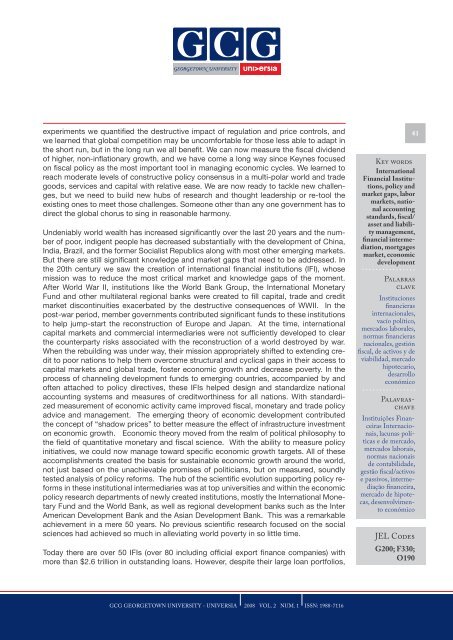2008 Vol. 2 Num. 1 - GCG: Revista de Globalización, Competitividad ...
2008 Vol. 2 Num. 1 - GCG: Revista de Globalización, Competitividad ...
2008 Vol. 2 Num. 1 - GCG: Revista de Globalización, Competitividad ...
Create successful ePaper yourself
Turn your PDF publications into a flip-book with our unique Google optimized e-Paper software.
experiments we quantified the <strong>de</strong>structive impact of regulation and price controls, andwe learned that global competition may be uncomfortable for those less able to adapt inthe short run, but in the long run we all benefit. We can now measure the fiscal divi<strong>de</strong>ndof higher, non-inflationary growth, and we have come a long way since Keynes focusedon fiscal policy as the most important tool in managing economic cycles. We learned toreach mo<strong>de</strong>rate levels of constructive policy consensus in a multi-polar world and tra<strong>de</strong>goods, services and capital with relative ease. We are now ready to tackle new challenges,but we need to build new hubs of research and thought lea<strong>de</strong>rship or re-tool theexisting ones to meet those challenges. Someone other than any one government has todirect the global chorus to sing in reasonable harmony.Un<strong>de</strong>niably world wealth has increased significantly over the last 20 years and the numberof poor, indigent people has <strong>de</strong>creased substantially with the <strong>de</strong>velopment of China,India, Brazil, and the former Socialist Republics along with most other emerging markets.But there are still significant knowledge and market gaps that need to be addressed. Inthe 20th century we saw the creation of international financial institutions (IFI), whosemission was to reduce the most critical market and knowledge gaps of the moment.After World War II, institutions like the World Bank Group, the International MonetaryFund and other multilateral regional banks were created to fill capital, tra<strong>de</strong> and creditmarket discontinuities exacerbated by the <strong>de</strong>structive consequences of WWII. In thepost-war period, member governments contributed significant funds to these institutionsto help jump-start the reconstruction of Europe and Japan. At the time, internationalcapital markets and commercial intermediaries were not sufficiently <strong>de</strong>veloped to clearthe counterparty risks associated with the reconstruction of a world <strong>de</strong>stroyed by war.When the rebuilding was un<strong>de</strong>r way, their mission appropriately shifted to extending creditto poor nations to help them overcome structural and cyclical gaps in their access tocapital markets and global tra<strong>de</strong>, foster economic growth and <strong>de</strong>crease poverty. In theprocess of channeling <strong>de</strong>velopment funds to emerging countries, accompanied by andoften attached to policy directives, these IFIs helped <strong>de</strong>sign and standardize nationalaccounting systems and measures of creditworthiness for all nations. With standardizedmeasurement of economic activity came improved fiscal, monetary and tra<strong>de</strong> policyadvice and management. The emerging theory of economic <strong>de</strong>velopment contributedthe concept of “shadow prices” to better measure the effect of infrastructure investmenton economic growth. Economic theory moved from the realm of political philosophy tothe field of quantitative monetary and fiscal science. With the ability to measure policyinitiatives, we could now manage toward specific economic growth targets. All of theseaccomplishments created the basis for sustainable economic growth around the world,not just based on the unachievable promises of politicians, but on measured, soundlytested analysis of policy reforms. The hub of the scientific evolution supporting policy reformsin these institutional intermediaries was at top universities and within the economicpolicy research <strong>de</strong>partments of newly created institutions, mostly the International MonetaryFund and the World Bank, as well as regional <strong>de</strong>velopment banks such as the InterAmerican Development Bank and the Asian Development Bank. This was a remarkableachievement in a mere 50 years. No previous scientific research focused on the socialsciences had achieved so much in alleviating world poverty in so little time.Today there are over 50 IFIs (over 80 including official export finance companies) withmore than $2.6 trillion in outstanding loans. However, <strong>de</strong>spite their large loan portfolios,41Key wordsInternationalFinancial Institutions,policy andmarket gaps, labormarkets, nationalaccountingstandards, fiscal/asset and liabilitymanagement,financial intermediation,mortgagesmarket, economic<strong>de</strong>velopmentPalabrasclaveInstitucionesfinancierasinternacionales,vacío político,mercados laborales,normas financierasnacionales, gestiónfiscal, <strong>de</strong> activos y <strong>de</strong>viabilidad, mercadohipotecario,<strong>de</strong>sarrolloeconómicoPalavraschaveInstituições FinanceirasInternacionais,lacunas políticase <strong>de</strong> mercado,mercados laborais,normas nacionais<strong>de</strong> contabilida<strong>de</strong>,gestão fiscal/activose passivos, intermediaçãofinanceira,mercado <strong>de</strong> hipotecas,<strong>de</strong>senvolvimentoeconómicoJEL Co<strong>de</strong>sG200; F330;O190<strong>GCG</strong> GEORGETOWN UNIVERSITY - UNIVERSIA <strong>2008</strong> VOL. 2 NUM. 1 ISSN: 1988-7116















